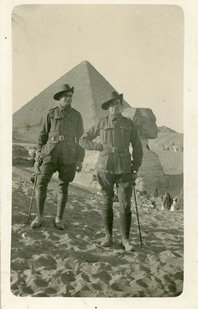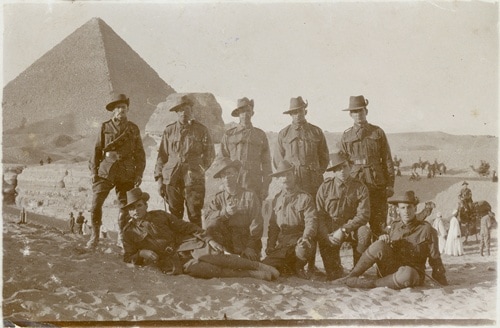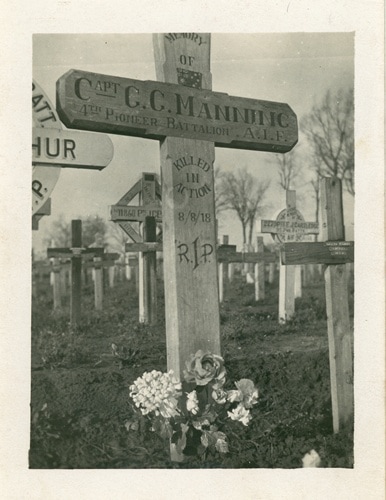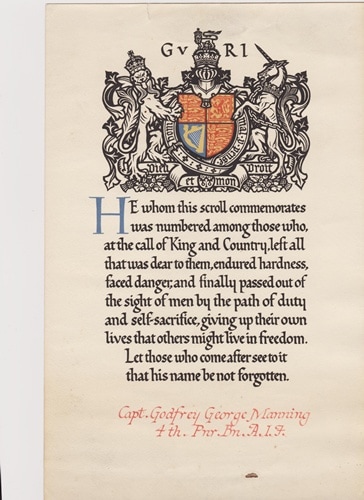Heath Cemetery
Roll of Honour
K - R
Dedication
16595 Private Thomas Hugh Milne, 9th Bn. King's Own (Royal Lancaster Regiment), 14th October 1915.
Remembered with honour by Barry Hubbard
16595 Private Thomas Hugh Milne, 9th Bn. King's Own (Royal Lancaster Regiment), 14th October 1915.
Remembered with honour by Barry Hubbard
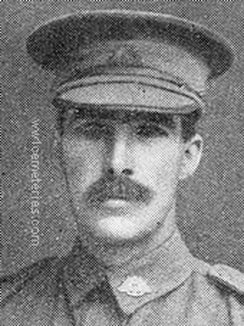
6744 Lance Corporal
James Kay
4th Bn. Australian Infantry, A. I. F.
23rd August 1918, aged 39.
Plot VI. A. 18.
From Auburn, NSW. A labourer prior to enlisting, he embarked from Sydney aboard SS Port Nicholson on 8 November 1916. He was killed in action at Proyart, France on 23 August 1918, aged 39.
James Kay
4th Bn. Australian Infantry, A. I. F.
23rd August 1918, aged 39.
Plot VI. A. 18.
From Auburn, NSW. A labourer prior to enlisting, he embarked from Sydney aboard SS Port Nicholson on 8 November 1916. He was killed in action at Proyart, France on 23 August 1918, aged 39.
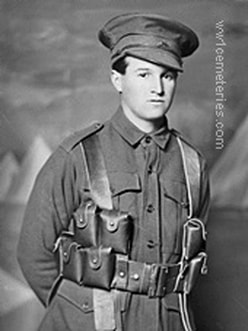
2192 Private
Leslie Herbert Knapp
59th Bn. Australian Infantry, A. I. F
12th September 1918, aged 21.
Plot IX. B. 20.
Originally buried in Proyart Communal Cemetery Extension and then concentrated into Heath Cemetery.
Son of Mrs. Matilda Smith, of 15, Fitzgerald St., South Yarra, Victoria, Australia.
His headstone bears the inscription: "Revered & Honoured As A Noble & Loyal Son; Mother."
He was a 19 year old telephonist when he enlisted in the AIF on 1 May 1916 and embarked for overseas with the 4th Reinforcements from Melbourne on 1 August 1916 aboard HMAT Orsova. Pte Knapp transferred to the 59th Battalion in France on 28 December 1916 and was still with that unit when he was wounded in action near Peronne, France on 2 September 1918. He died of wounds on 12 September 1918 and is buried in the Heath Cemetery, Harbonnieres, France.
5116 Driver Charles Edward.Hills of the same battalion said:
"At Peronne on September 2nd 1918, at 5pm, he went out to bring in a wounded man and received a snipers bullet in the chest. A bad wound. He was conscious and walked back to the R. A. P. (Regimental Aid Post.) I know nothing of his death and burial."
Further information was received from 3165 Private Charles Percy Hughes who added:
"He died at the 5th C. C. S. (Casualty Clearing Station) He appeared to be getting on pretty well when I saw him there on 8th September 1918, I think he was wounded near Peronne by a Machine Gun bullet in the left lung."
Both of the above witnesses survived the war.
Leslie Herbert Knapp
59th Bn. Australian Infantry, A. I. F
12th September 1918, aged 21.
Plot IX. B. 20.
Originally buried in Proyart Communal Cemetery Extension and then concentrated into Heath Cemetery.
Son of Mrs. Matilda Smith, of 15, Fitzgerald St., South Yarra, Victoria, Australia.
His headstone bears the inscription: "Revered & Honoured As A Noble & Loyal Son; Mother."
He was a 19 year old telephonist when he enlisted in the AIF on 1 May 1916 and embarked for overseas with the 4th Reinforcements from Melbourne on 1 August 1916 aboard HMAT Orsova. Pte Knapp transferred to the 59th Battalion in France on 28 December 1916 and was still with that unit when he was wounded in action near Peronne, France on 2 September 1918. He died of wounds on 12 September 1918 and is buried in the Heath Cemetery, Harbonnieres, France.
5116 Driver Charles Edward.Hills of the same battalion said:
"At Peronne on September 2nd 1918, at 5pm, he went out to bring in a wounded man and received a snipers bullet in the chest. A bad wound. He was conscious and walked back to the R. A. P. (Regimental Aid Post.) I know nothing of his death and burial."
Further information was received from 3165 Private Charles Percy Hughes who added:
"He died at the 5th C. C. S. (Casualty Clearing Station) He appeared to be getting on pretty well when I saw him there on 8th September 1918, I think he was wounded near Peronne by a Machine Gun bullet in the left lung."
Both of the above witnesses survived the war.
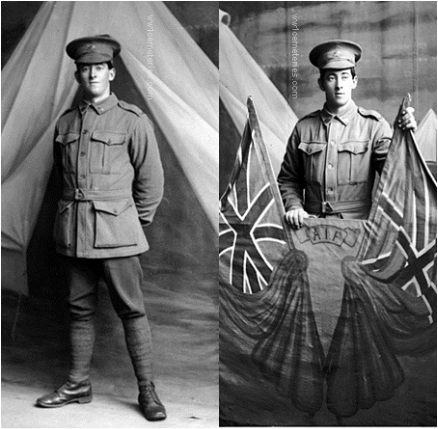
6296 Private
Allen Knight
6th Bn. Australian Infantry, A. I. F.
23rd August 1918, aged 24.
Plot V. C. 18.
Originally buried in the Rosieres Cemetery (Probably Clump Trench Cemetery.)
Son of Allen and Mary Jane Knight, of Percy St., Portland, Victoria, Australia. Born at Quantong, Victoria.
His headstone bears the inscription' "To Memory Ever Dear."
A 22 year old orchardist prior to enlisting on 28 April 1916, he embarked for overseas with the 20th Reinforcements from Melbourne on 11 September 1916 aboard HMAT Euripides (A14). Following further training in England and France, he joined the 6th Battalion on 9 February 1917. While serving on the Western Front, he was killed in action near Rainecourt, France.
6851 Corporal H. Simmons witnessed Private Knight's death:
"He was a Private in 'A' Company, 6th battalion. No.1 on Lewis Gun, tall, thin, fair. I saw him hit in front of St. Denis Wood on the 23rd August about 6.00 a.m. during the advance on the wood. A shell landed amongst the gun team, he was hit all over and killed instantly and 3 others were wounded. The whole team was hit during the day except myself. It was about 20 minutes after the hop over when he was killed. We went on and I know no more of him."
Allen Knight
6th Bn. Australian Infantry, A. I. F.
23rd August 1918, aged 24.
Plot V. C. 18.
Originally buried in the Rosieres Cemetery (Probably Clump Trench Cemetery.)
Son of Allen and Mary Jane Knight, of Percy St., Portland, Victoria, Australia. Born at Quantong, Victoria.
His headstone bears the inscription' "To Memory Ever Dear."
A 22 year old orchardist prior to enlisting on 28 April 1916, he embarked for overseas with the 20th Reinforcements from Melbourne on 11 September 1916 aboard HMAT Euripides (A14). Following further training in England and France, he joined the 6th Battalion on 9 February 1917. While serving on the Western Front, he was killed in action near Rainecourt, France.
6851 Corporal H. Simmons witnessed Private Knight's death:
"He was a Private in 'A' Company, 6th battalion. No.1 on Lewis Gun, tall, thin, fair. I saw him hit in front of St. Denis Wood on the 23rd August about 6.00 a.m. during the advance on the wood. A shell landed amongst the gun team, he was hit all over and killed instantly and 3 others were wounded. The whole team was hit during the day except myself. It was about 20 minutes after the hop over when he was killed. We went on and I know no more of him."
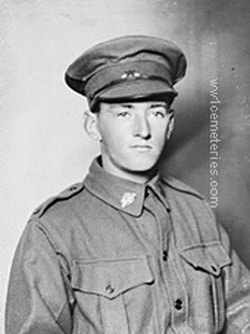
5398A Lance Corporal
Harry James Lamprell, M. M.
14th Bn. Australian Infantry, A. I. F.
8th August 1918, aged 22.
Plot III. G. 11.
Son of James Lamprell and of Edith Mary Smith, of Turner St., North Wonthaggi, Victoria, Australia.
His headstone bears the inscription "A Beautiful Memory Left Behind Of A Loving Son So True And Kind."
A driver from Wonthaggi, Victoria prior to enlistment, Pte Lamprell embarked with the 18th Reinforcements from Melbourne on HMAT Ayrshire on 3 July 1916. Later transferring to the 14th Battalion with the service number of 5398A, he was awarded the Military Medal "For conspicuous bravery...in the attack of the Hindenburg Line. He was the only one left of his bombing section but continued to throw his bombs and held the enemy back for a considerable time." Later promoted to Lance Corporal he was wounded in action and on 8th August 1918, aged 22, he was killed in action.
Harry James Lamprell, M. M.
14th Bn. Australian Infantry, A. I. F.
8th August 1918, aged 22.
Plot III. G. 11.
Son of James Lamprell and of Edith Mary Smith, of Turner St., North Wonthaggi, Victoria, Australia.
His headstone bears the inscription "A Beautiful Memory Left Behind Of A Loving Son So True And Kind."
A driver from Wonthaggi, Victoria prior to enlistment, Pte Lamprell embarked with the 18th Reinforcements from Melbourne on HMAT Ayrshire on 3 July 1916. Later transferring to the 14th Battalion with the service number of 5398A, he was awarded the Military Medal "For conspicuous bravery...in the attack of the Hindenburg Line. He was the only one left of his bombing section but continued to throw his bombs and held the enemy back for a considerable time." Later promoted to Lance Corporal he was wounded in action and on 8th August 1918, aged 22, he was killed in action.
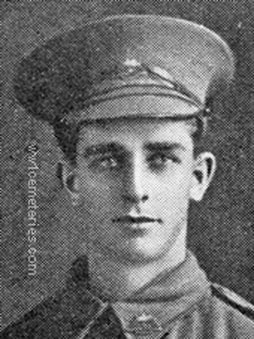
6776 Private
Harold Edward Lassau
2nd Bn. Australian Infantry, A. I. F.
23rd August 1918, aged 22.
Plot III. G. 16.
Almost certainly originally buried in the Proyart Communal Cemetery Extension, his grave later being concentrated into Heath Cemetery.
Son of Randolph Alfred and Emily Lassau, of Beatrice St., Lidcombe, New South Wales. Born at Waverley, New South Wales.
A musician prior to enlisting, he embarked from Sydney aboard SS Port Nicholson on 8 November 1916. He was killed in action, on 23 August 1918, near Proyart, France, aged 22. His brother, 5818 Pte Randolph Lassau was killed in action on 3 May 1917 and buried at Queant Road Cemetery.
Harold Edward Lassau
2nd Bn. Australian Infantry, A. I. F.
23rd August 1918, aged 22.
Plot III. G. 16.
Almost certainly originally buried in the Proyart Communal Cemetery Extension, his grave later being concentrated into Heath Cemetery.
Son of Randolph Alfred and Emily Lassau, of Beatrice St., Lidcombe, New South Wales. Born at Waverley, New South Wales.
A musician prior to enlisting, he embarked from Sydney aboard SS Port Nicholson on 8 November 1916. He was killed in action, on 23 August 1918, near Proyart, France, aged 22. His brother, 5818 Pte Randolph Lassau was killed in action on 3 May 1917 and buried at Queant Road Cemetery.

Captain
Louis Leon Le Nay Mentioned in Despatches
11th Bn. Australian Infantry
10th August 1918, aged 27.
Plot IV. J. 4.
Son of Louis Francois Arteme and Esther Louise Marie Le Nay; husband of Kathleen (married 1917); father of Desmond (born 15 August 1918, England).
His headstone bears the inscription; "In Loving Memory Of My Husband And Father Of Desmond Born 15.8.18."
Captain Louis Le Nay (1891-1918), born in NSW lived in Meckering, Western Australia, enlisted in the AIF 11 Battalion 7 January 1915 (service number 11536), shipped from Fremantle on Themistocles 13 September 1915, a machinery expert and gunner (Lewis gunner), died in combat at Villers-Bretonneux aged 27 on 10 August 1918 (amongst the “Battle of Amiens”). Buried Heath Cemetery Harbonnieres France (Plot IV Row J Grave No 4).
Pictures and information courtesy of his Kelly family nephews and nieces
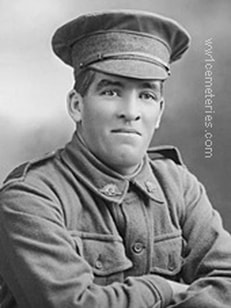
240 Private
Wilfred Joseph Lukeman, M. M.
4th Bn. Australian Infantry, A. I. F.
23rd August 1918, aged 32.
Plot VI. A. 17.
Son of James and Marie Lukeman, of 270, Johnston St., Annandale, New South Wales. Born at Yass, New South Wales.
His headstone bears the inscription; "Greater Love Hath No Man Than This."
Wilfred Joseph Lukeman, M. M.
4th Bn. Australian Infantry, A. I. F.
23rd August 1918, aged 32.
Plot VI. A. 17.
Son of James and Marie Lukeman, of 270, Johnston St., Annandale, New South Wales. Born at Yass, New South Wales.
His headstone bears the inscription; "Greater Love Hath No Man Than This."
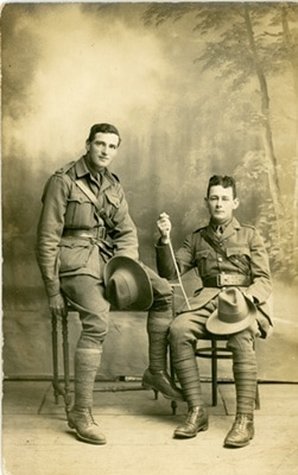
Captain
Godfrey George Manning
4th Bn. Australian Pioneers
8th August 1918, aged 28.
Plot VII. C. 2.
Son of John and Sophia Manning, of 71, Clyde St., Northcote, Victoria, Australia. Born at Traralgon, Victoria
His headstone bears the inscription; ""Dick" He Died For Us."
Godfrey George Manning is on the left
The Fate of So Many
(All pictures and text by Ken Wright)
It’s not the nicest of experiences clearing out a deceased estate. The presence of two generations of the Manning family who lived in the house seems to permeate every room and everything one touches. The feeling of being watched while removing the paintings from the walls which were the mothers pride and joy. Or when moving the furniture in the sunroom where the family would spend time watching television or chat about the day’s events. Again, when carrying the study desk on which the son, an extremely well-liked and respected Roman Catholic priest perhaps drafted his sermons, wrote to the needy or read chapters from his extensive collection of religious books. All gone! It is as though they never existed.
Most of the house contents went to charity but a mountain of private papers had to be sorted. A very time consuming task and as time was short, cursory glances were made of each piece of paper, diary, folders and anything deemed not important was placed in the waste paper recycling bin. As the contents of the desk were being quickly sorted, the photograph of a soldier’s grave from the Great War was almost missed. A relative of the deceased family obviously but whereabouts on the family tree was an unknown factor. As the cleanout continued, nothing further about the soldier was found in the house but in the garage in an old cupboard full of stored household contents, further military paraphernalia was discovered. Of special interest was the Bronze disk commonly known as a ‘Dead Man’s Penny’ still in its original cardboard presentation folder still with the dedication certificate. Sadly, no personal letters were found which would have been a valuable record of the soldier’s feelings of the time, and perhaps an insight into his hopes and dreams for the future. 1
Sapper Godfrey George Manning, regimental number 99 of the 2nd Field Company Engineers departed Melbourne 21 October 1914 with 1,347 other men of the Australian Imperial Force including 91 officers aboard the 12,130 ton transport ship Orvieto. The transport was part of a 36 ship convoy escorted by HMAS Melbourne and HMAS Sydney and cruisers from the Royal Navy and the Imperial Japanese Navy. Soon after arrival at Alexandria in Egypt on 2 December, the troops began acclimatisation and training then took part in the landing at Gallipoli on 25 April 1915 together with troops from New Zealand, Britain and France. The 2nd Field Company went in with the second and third waves.
Godfrey George Manning
4th Bn. Australian Pioneers
8th August 1918, aged 28.
Plot VII. C. 2.
Son of John and Sophia Manning, of 71, Clyde St., Northcote, Victoria, Australia. Born at Traralgon, Victoria
His headstone bears the inscription; ""Dick" He Died For Us."
Godfrey George Manning is on the left
The Fate of So Many
(All pictures and text by Ken Wright)
It’s not the nicest of experiences clearing out a deceased estate. The presence of two generations of the Manning family who lived in the house seems to permeate every room and everything one touches. The feeling of being watched while removing the paintings from the walls which were the mothers pride and joy. Or when moving the furniture in the sunroom where the family would spend time watching television or chat about the day’s events. Again, when carrying the study desk on which the son, an extremely well-liked and respected Roman Catholic priest perhaps drafted his sermons, wrote to the needy or read chapters from his extensive collection of religious books. All gone! It is as though they never existed.
Most of the house contents went to charity but a mountain of private papers had to be sorted. A very time consuming task and as time was short, cursory glances were made of each piece of paper, diary, folders and anything deemed not important was placed in the waste paper recycling bin. As the contents of the desk were being quickly sorted, the photograph of a soldier’s grave from the Great War was almost missed. A relative of the deceased family obviously but whereabouts on the family tree was an unknown factor. As the cleanout continued, nothing further about the soldier was found in the house but in the garage in an old cupboard full of stored household contents, further military paraphernalia was discovered. Of special interest was the Bronze disk commonly known as a ‘Dead Man’s Penny’ still in its original cardboard presentation folder still with the dedication certificate. Sadly, no personal letters were found which would have been a valuable record of the soldier’s feelings of the time, and perhaps an insight into his hopes and dreams for the future. 1
Sapper Godfrey George Manning, regimental number 99 of the 2nd Field Company Engineers departed Melbourne 21 October 1914 with 1,347 other men of the Australian Imperial Force including 91 officers aboard the 12,130 ton transport ship Orvieto. The transport was part of a 36 ship convoy escorted by HMAS Melbourne and HMAS Sydney and cruisers from the Royal Navy and the Imperial Japanese Navy. Soon after arrival at Alexandria in Egypt on 2 December, the troops began acclimatisation and training then took part in the landing at Gallipoli on 25 April 1915 together with troops from New Zealand, Britain and France. The 2nd Field Company went in with the second and third waves.
Godfrey George Manning in Cairo
With the possible exception of the Crimean War, the Gallipoli campaign was the most poorly mounted and ineptly controlled operation in modern British military history. One of the many mistakes of the ill-fated campaign was the fact that the Australians were landed at least 1.6 kilometres from the original landing point. Another was that surprise had been lost even before the inception of the plan. The British practically advertised their intentions by carrying out a premature bombardment of the outer Dardanelles defences by a British naval force in November 1914. This naturally alerted both the Turks and the Germans to the danger of a future attack. When British High Command finally realised there was no point in continuing the campaign after 8 months and thousands dead or wounded with no end to the stalemate, a very successful evacuation was carried out. Beginning 19 December and over a total of 11 nights, approximately 80,000 men with only 6 wounded were withdrawn from the beaches and cliffs of Gallipoli. The Australians returned to Egypt then in March 1916, sailed for France and the horrors of the Western Front. 2
Sapper Manning rose through the ranks to become Captain in December 1917and attended various training courses before being transferred to 4th Pioneer Battalion which had been formed in Egypt during August 1915. His last course was with the Royal Engineers School in March 1918 at Rouen which was open to officers and NCO’s of Pioneer Battalions. Captain Manning re-joined the 4th Battalion in the field after the 23 day course and the following month, was mentioned in Sir Douglas Haig’s dispatch submitting names deserving of special mention for services in the field. 3
The Battle of Amiens, fought between 8 and 11 August 1918, marked the beginning of the British advance that culminated in the Armistice of 11 November 1918. The preparations for the battle included unprecedented security in order to achieve maximum surprise. The Canadian Corps was secretly moved to the Somme area and took over the southern half of the Australian frontline. The Australian Corps was concentrated between the Canadians and the Somme River while the British held the line north of the river. The infantry moved into their assembly positions in the small hours of 8 August. A dense fog gathered and unseen aeroplanes droning above drowned out the noise of the tanks that would support the infantry.
The fog was still dense at 4-20 am when the artillery barrage opened fire and the advance began. The early attacks were carried out in the dense fog with infantry and tanks’ moving in what they hoped was the right direction. The first objective was seized by 7-30 and some German positions were bypassed and then attacked in the rear. Most of the German field artillery was over run and quickly captured. By 8-30 the fog had begun to thin out and fresh troops resumed the advance. The Australian official historian Charles Bean wrote, ‘A little later the mist suddenly cleared, and for a moment all eyes on the battlefield took in the astonishing scene. Infantry in lines of hundreds of little sections-columns all moving forward-with tanks, guns, battery after battery.’ 4
When the fog lifted, German guns opened up at the tanks and put many out of action but the Australian infantry kept going and soon overran most of the guns. The greater part of the final objective for the day, the old outer line of the Amiens defence system, was captured. The Canadian and French attacks had gone as well as those of the Australians and 25 kilometres of the German front south of the Somme was swept away in a victory that far surpassed any previous success of the British Army on the Western Front. More than 13,000 Germans were made prisoners and more than 200 guns captured. A British officer wrote in the 4th British Army’s war diary that the Australian Corps had in the preceding months gained ‘a mastery over the enemy such as has probably not been gained by our troops in any previous period of the war.’ 5 General Eric von Ludendorff, the German commander, later wrote of August 8,
‘It was the black day of the German Army in this war. The 8th of August put the decline of that [German] fighting power beyond all doubt. The war must be ended.’ 6.
Following up behind the infantry were the Australian Pioneer Battalions. While, in an emergency, they could, and were, used as infantry, their primary purpose was to maintain the roads and tracks so essential to battlefield communications and the carriage of supplies. As the fighting moved further on, 4 Pioneer Battalion advanced about 3 km north of Heath Cemetery along the Somme River. That evening Captain Godfrey Manning and Sergeant Ernest Sumner went out to look for a position for Manning's company to dig in for the night.
Sergeant Sumner recounts the events concerning Captain Manning’s death. He stated; ‘As you will recollect, August 8 was very successful day for us and after the advance on our sector was completed, Captain Manning and myself went out to reconnoitre the position ahead of us for the purpose of selecting suitable localities for consolidation during the night. This work of course entailed a certain amount of risk and exposure to the enemy and as we knew the enemy to be occupying a wood immediately opposite, we took the necessary precautions as far as we were able as usual in such cases. It is not unusual for the enemy however, to have guns concealed in such forward places but owing to the serious reverse he [the enemy] had experienced during the day they apparently had not sufficient time to remove their guns from this wood and after we had been engaged on our task for some little time, they opened direct fire at us with low bursting high explosive shrapnel. The first few shots were rather wide of the mark and we took little heed of them but when they began falling closer we realised we were under direct fire from the enemy's guns. We thought it wise to take cover and just as we turned our backs and were walking away a shell burst a few yards in the rear of us with the result of this, shrapnel penetrated the centre of the Captains back killing him instantly. I immediately turned him over but I found death already imprinted upon his face and anything in the nature of first aid was absolutely useless. I crawled into an old trench nearby and after the shelling had subsided I went and collected what papers he had about him and handed same to one of his fellow officers. That morning, I proceeded to the spot again and had his body carried back to a small village named Morcourt situated on the south bank of the river Somme. His remains were interred in a small cemetery [military] forming part of the civilian cemetery and adjoining the village. A cross was by later erected on his grave by some of his fellow comrade's and when I had occasion to pass near there about six weeks later I made it my business to have a look at his grave which I found was quite intact. I might be permitted to add, I was greatly distressed by the occurrence of this fatality and my deepest sympathy goes to his dear relatives and friends soliciting enquiries concerning him and it was with universal regret that I made known to his comrades of his sad fate for all realised that they had lost a brave and fearless officer, and one who had the respect and esteem of all. 7
The advance continued on the following days with the Australians taking Etinehem, Lihons and Proyart. Australian causalities for the offensive, mainly from 9-12 August, were 6,000 killed and wounded.
Perhaps a visitor to the Harbonnières, Heath Cemetery in France, might casually stop at Plot V11, Row C, Grave 2 and read the headstone of 28 year old Captain [Dicky] Manning, 4th Pioneer Battalion, AIF and wonder briefly who he was and what he part he played in the war. In fact, how many headstones have names of those who made the ultimate sacrifice and remain unknown? ‘Who were they and what did they do?’
Sapper Manning rose through the ranks to become Captain in December 1917and attended various training courses before being transferred to 4th Pioneer Battalion which had been formed in Egypt during August 1915. His last course was with the Royal Engineers School in March 1918 at Rouen which was open to officers and NCO’s of Pioneer Battalions. Captain Manning re-joined the 4th Battalion in the field after the 23 day course and the following month, was mentioned in Sir Douglas Haig’s dispatch submitting names deserving of special mention for services in the field. 3
The Battle of Amiens, fought between 8 and 11 August 1918, marked the beginning of the British advance that culminated in the Armistice of 11 November 1918. The preparations for the battle included unprecedented security in order to achieve maximum surprise. The Canadian Corps was secretly moved to the Somme area and took over the southern half of the Australian frontline. The Australian Corps was concentrated between the Canadians and the Somme River while the British held the line north of the river. The infantry moved into their assembly positions in the small hours of 8 August. A dense fog gathered and unseen aeroplanes droning above drowned out the noise of the tanks that would support the infantry.
The fog was still dense at 4-20 am when the artillery barrage opened fire and the advance began. The early attacks were carried out in the dense fog with infantry and tanks’ moving in what they hoped was the right direction. The first objective was seized by 7-30 and some German positions were bypassed and then attacked in the rear. Most of the German field artillery was over run and quickly captured. By 8-30 the fog had begun to thin out and fresh troops resumed the advance. The Australian official historian Charles Bean wrote, ‘A little later the mist suddenly cleared, and for a moment all eyes on the battlefield took in the astonishing scene. Infantry in lines of hundreds of little sections-columns all moving forward-with tanks, guns, battery after battery.’ 4
When the fog lifted, German guns opened up at the tanks and put many out of action but the Australian infantry kept going and soon overran most of the guns. The greater part of the final objective for the day, the old outer line of the Amiens defence system, was captured. The Canadian and French attacks had gone as well as those of the Australians and 25 kilometres of the German front south of the Somme was swept away in a victory that far surpassed any previous success of the British Army on the Western Front. More than 13,000 Germans were made prisoners and more than 200 guns captured. A British officer wrote in the 4th British Army’s war diary that the Australian Corps had in the preceding months gained ‘a mastery over the enemy such as has probably not been gained by our troops in any previous period of the war.’ 5 General Eric von Ludendorff, the German commander, later wrote of August 8,
‘It was the black day of the German Army in this war. The 8th of August put the decline of that [German] fighting power beyond all doubt. The war must be ended.’ 6.
Following up behind the infantry were the Australian Pioneer Battalions. While, in an emergency, they could, and were, used as infantry, their primary purpose was to maintain the roads and tracks so essential to battlefield communications and the carriage of supplies. As the fighting moved further on, 4 Pioneer Battalion advanced about 3 km north of Heath Cemetery along the Somme River. That evening Captain Godfrey Manning and Sergeant Ernest Sumner went out to look for a position for Manning's company to dig in for the night.
Sergeant Sumner recounts the events concerning Captain Manning’s death. He stated; ‘As you will recollect, August 8 was very successful day for us and after the advance on our sector was completed, Captain Manning and myself went out to reconnoitre the position ahead of us for the purpose of selecting suitable localities for consolidation during the night. This work of course entailed a certain amount of risk and exposure to the enemy and as we knew the enemy to be occupying a wood immediately opposite, we took the necessary precautions as far as we were able as usual in such cases. It is not unusual for the enemy however, to have guns concealed in such forward places but owing to the serious reverse he [the enemy] had experienced during the day they apparently had not sufficient time to remove their guns from this wood and after we had been engaged on our task for some little time, they opened direct fire at us with low bursting high explosive shrapnel. The first few shots were rather wide of the mark and we took little heed of them but when they began falling closer we realised we were under direct fire from the enemy's guns. We thought it wise to take cover and just as we turned our backs and were walking away a shell burst a few yards in the rear of us with the result of this, shrapnel penetrated the centre of the Captains back killing him instantly. I immediately turned him over but I found death already imprinted upon his face and anything in the nature of first aid was absolutely useless. I crawled into an old trench nearby and after the shelling had subsided I went and collected what papers he had about him and handed same to one of his fellow officers. That morning, I proceeded to the spot again and had his body carried back to a small village named Morcourt situated on the south bank of the river Somme. His remains were interred in a small cemetery [military] forming part of the civilian cemetery and adjoining the village. A cross was by later erected on his grave by some of his fellow comrade's and when I had occasion to pass near there about six weeks later I made it my business to have a look at his grave which I found was quite intact. I might be permitted to add, I was greatly distressed by the occurrence of this fatality and my deepest sympathy goes to his dear relatives and friends soliciting enquiries concerning him and it was with universal regret that I made known to his comrades of his sad fate for all realised that they had lost a brave and fearless officer, and one who had the respect and esteem of all. 7
The advance continued on the following days with the Australians taking Etinehem, Lihons and Proyart. Australian causalities for the offensive, mainly from 9-12 August, were 6,000 killed and wounded.
Perhaps a visitor to the Harbonnières, Heath Cemetery in France, might casually stop at Plot V11, Row C, Grave 2 and read the headstone of 28 year old Captain [Dicky] Manning, 4th Pioneer Battalion, AIF and wonder briefly who he was and what he part he played in the war. In fact, how many headstones have names of those who made the ultimate sacrifice and remain unknown? ‘Who were they and what did they do?’
The picture on the left is the original grave marker in Heath Cemetery
It is a sad fact of life that so many valuable documents, letters, medals and other personal military paraphernalia of deceased service men and women of all nationalities will and are lost through neglect, uninterested relatives or plain ignorance. Unless their stories are recorded or at least donated to an interested authority and not discarded like a bit of rubbish, their part of history will be lost forever. This was almost the fate of Captain G.G.Manning.
Footnotes.
© Ken Wright. 2011.
Footnotes.
- The Dead Man’s Penny is a 12 centimetre disk cast in bronze gunmetal which incorporated the following; an image of Britannia and a lion, two dolphins representing Britain’s sea power and the emblem of Imperial Germany’s eagle being torn to pieces by another lion. Britannia is holding an oak spray with leaves and acorns. Beneath this is rectangular tablet where the deceased individual’s name was cast into the plaque. No rank was given as it was intended to show equality in their sacrifice. Engraved on the outer edge of the disk, the words, ‘He died for freedom and honour.’ This disk was an official form of gratitude given to the fallen service men and women’s bereaved next of kin.
- Evacuated December 1915.
- 7 April 1918.Promulagated,’London Gazette’, 28 May 1918.’
- Been. Charles. Anzac to Amiens, Canberra, 1940, p.471.
- Been, Charles. p 470.
- Ludendorff, quoted by Charles Bean, Anzac to Amiens, page 473.
- Sumner. E.A. Sergeant. D Coy. 4th Pioneer Battalion. A.I.F. Belgium.
© Ken Wright. 2011.
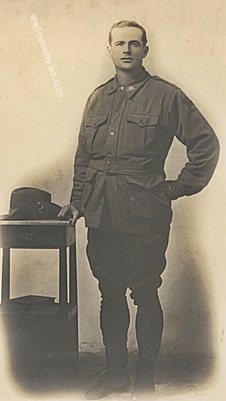
383 Private
Harry Douglas Bennett McPaul
17th Bn. Australian Infantry, A. I. F.
11th August 1918, aged 32.
Plot IV. B. 7.
Son of Thomas Henry and Annie Louisa McPaul, of "Tekuti," Waine St., North Manley, New South Wales. Born at Wolumla, New South Wales.
His headstone bears the inscription; "My Presence Shall Go With Thee And I Will Give Thee Rest" (Quote taken from Exodus 33:14.)
Harry Douglas Bennett McPaul
17th Bn. Australian Infantry, A. I. F.
11th August 1918, aged 32.
Plot IV. B. 7.
Son of Thomas Henry and Annie Louisa McPaul, of "Tekuti," Waine St., North Manley, New South Wales. Born at Wolumla, New South Wales.
His headstone bears the inscription; "My Presence Shall Go With Thee And I Will Give Thee Rest" (Quote taken from Exodus 33:14.)
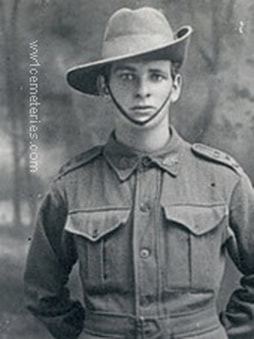
854 Lance Corporal
Ernest Albert Millar
42nd Bn. Australian Infantry, A. i. F.
12th August 1918, aged 21.
Plot X. B. 14.
Originally buried in Proyart Communal Cemetery Extension, his grave later being concentrated into Heath Cemetery.
Son of Thomas Parkin Millar and Mary Ann Millar, of Palmwoods, Queensland.
His headstone bears the inscription; "He Died The Helpless To Defend; An Australian Soldier's Noble End."
A teamster prior to enlistment, Pte Millar embarked from Sydney, NSW, on board HMAT Borda (A30) on 5 June 1916. He was promoted to Lance Corporal (L/Cpl) on 2 September 1917 and he was a Lewis gunner for his platoon. He was killed in action on 12 August 1918 during an attack at Proyart, France.
Ernest Albert Millar
42nd Bn. Australian Infantry, A. i. F.
12th August 1918, aged 21.
Plot X. B. 14.
Originally buried in Proyart Communal Cemetery Extension, his grave later being concentrated into Heath Cemetery.
Son of Thomas Parkin Millar and Mary Ann Millar, of Palmwoods, Queensland.
His headstone bears the inscription; "He Died The Helpless To Defend; An Australian Soldier's Noble End."
A teamster prior to enlistment, Pte Millar embarked from Sydney, NSW, on board HMAT Borda (A30) on 5 June 1916. He was promoted to Lance Corporal (L/Cpl) on 2 September 1917 and he was a Lewis gunner for his platoon. He was killed in action on 12 August 1918 during an attack at Proyart, France.
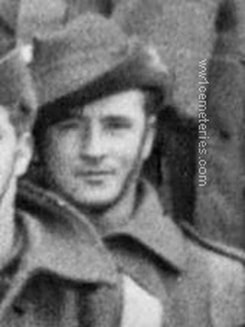
2277 Corporal
George Leonard Miller
32nd Bn. Australian Infantry, A. I. F.
27th August 1918, aged 23.
Plot II. B. 19.
Son of John Collins Miller and Elizabeth Miller, of 109, Nicholl St., Cornish St., Railway Town, Broken Hill, New South Wales.
His headstone bears the inscription; "For Ever With The Lord Amen, So Let It Be." (From the hymn 'For Ever With The Lord' by James Montgomery.
George Leonard Miller
32nd Bn. Australian Infantry, A. I. F.
27th August 1918, aged 23.
Plot II. B. 19.
Son of John Collins Miller and Elizabeth Miller, of 109, Nicholl St., Cornish St., Railway Town, Broken Hill, New South Wales.
His headstone bears the inscription; "For Ever With The Lord Amen, So Let It Be." (From the hymn 'For Ever With The Lord' by James Montgomery.
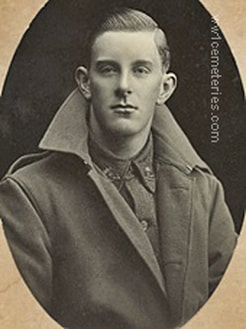
7515 Private
Victor Fortescue Morris
5th Bn. Australian Infantry, A. I. F.
25th August 1918, aged 20.
Plot VI. H. 15.
Son of Percy Fortescue Morris and Frances Mary Morris, of Orbost, Victoria, Australia.
His headstone bears the inscription; "Greater Love Hath No Man; He Gave His Life For His Friends."
Pte Morris of Orbost, Victoria, embarked on 4 August 1917 from Melbourne aboard HMAT Themistocles A32. He was Killed in action on 25 August 1918 near Harbonnieres, France.
Victor Fortescue Morris
5th Bn. Australian Infantry, A. I. F.
25th August 1918, aged 20.
Plot VI. H. 15.
Son of Percy Fortescue Morris and Frances Mary Morris, of Orbost, Victoria, Australia.
His headstone bears the inscription; "Greater Love Hath No Man; He Gave His Life For His Friends."
Pte Morris of Orbost, Victoria, embarked on 4 August 1917 from Melbourne aboard HMAT Themistocles A32. He was Killed in action on 25 August 1918 near Harbonnieres, France.
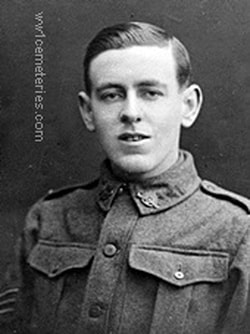
3429 Lance Sergeant
Frederick Charles Mundelein
7th Bn. Australian Infantry, A. I. F.
9th August 1918, aged 22.
Plot IV. H. 4.
Son of Charles and Victoria Mundelein. Born at Bendigo, Victoria, Australia.
A bank clerk of Bendigo, Vic, he enlisted on 15 July 1915 and sailed with the 11th Reinforcements aboard HMAT Nestor on 11 October 1915.
4670 Private, D. G. Reeves witnessed Fred Mundelein's death:
"I knew him well, he was tall and very thin. On the 9th August we were at Rosieres and attacked in the afternoon, we had got our objective when Mundelein sprained his ankle and was ordered to go back to the Dressing Station. While on his way back, he was hit by a bullet and killed outright. I saw his body lying where it was hit, it was buried at the battalion cemetery about half a mile from Rosieres Ridge."
7569 Signaller, A. Teasdale added:
"I knew Sergeant Fred Mundelein. I saw his grave; he is buried in the same grave as my mate, Private J. A. Maher*, HQ Signaller. It is in the open, on the ridge about 500 yards to the left of Rosieres Railway Station. I went up to tidy the grave, both names are on the temporary crosses on the grave. The engineers were to put a regulation cross on it."
*7522 Private, James Aloysious Timothy Maher, 7th Bn. Australian Infantry, A. I. F. killed 9th August 1918. Now buried in Plot IV. H. 5. next to Fred Mundelein at Heath Cemetery.
Frederick Charles Mundelein
7th Bn. Australian Infantry, A. I. F.
9th August 1918, aged 22.
Plot IV. H. 4.
Son of Charles and Victoria Mundelein. Born at Bendigo, Victoria, Australia.
A bank clerk of Bendigo, Vic, he enlisted on 15 July 1915 and sailed with the 11th Reinforcements aboard HMAT Nestor on 11 October 1915.
4670 Private, D. G. Reeves witnessed Fred Mundelein's death:
"I knew him well, he was tall and very thin. On the 9th August we were at Rosieres and attacked in the afternoon, we had got our objective when Mundelein sprained his ankle and was ordered to go back to the Dressing Station. While on his way back, he was hit by a bullet and killed outright. I saw his body lying where it was hit, it was buried at the battalion cemetery about half a mile from Rosieres Ridge."
7569 Signaller, A. Teasdale added:
"I knew Sergeant Fred Mundelein. I saw his grave; he is buried in the same grave as my mate, Private J. A. Maher*, HQ Signaller. It is in the open, on the ridge about 500 yards to the left of Rosieres Railway Station. I went up to tidy the grave, both names are on the temporary crosses on the grave. The engineers were to put a regulation cross on it."
*7522 Private, James Aloysious Timothy Maher, 7th Bn. Australian Infantry, A. I. F. killed 9th August 1918. Now buried in Plot IV. H. 5. next to Fred Mundelein at Heath Cemetery.
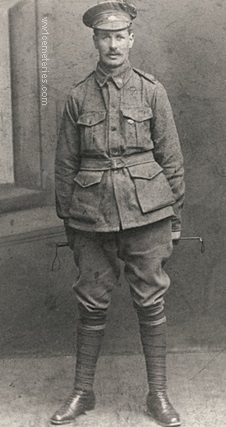
6504 Private
Sydney Murrell
12th Bn. Australian Infantry, A. I. F.
23rd August 1918, aged 26.
Plot X. B. 15.
Son of Charlie Fredrick and Mary Ann Murrell; husband of Nellie Lynda Murrell, of Castle Forbes Bay, Tasmania.
His headstone bears the inscription; "Have Mercy Upon Him Lord And Let Perpetual Light Shine Upon Him."
An orchardist from Castle Forbes Bay, Tasmania prior to enlistment, Pte Murrell embarked with the 21st Reinforcements from Melbourne on HMAT Suffolk on 30 September 1916. Later wounded in action, he remained on duty. Subsequently gassed he was evacuated to England. On rejoining his unit, he was killed in action in France.
Sydney Murrell
12th Bn. Australian Infantry, A. I. F.
23rd August 1918, aged 26.
Plot X. B. 15.
Son of Charlie Fredrick and Mary Ann Murrell; husband of Nellie Lynda Murrell, of Castle Forbes Bay, Tasmania.
His headstone bears the inscription; "Have Mercy Upon Him Lord And Let Perpetual Light Shine Upon Him."
An orchardist from Castle Forbes Bay, Tasmania prior to enlistment, Pte Murrell embarked with the 21st Reinforcements from Melbourne on HMAT Suffolk on 30 September 1916. Later wounded in action, he remained on duty. Subsequently gassed he was evacuated to England. On rejoining his unit, he was killed in action in France.
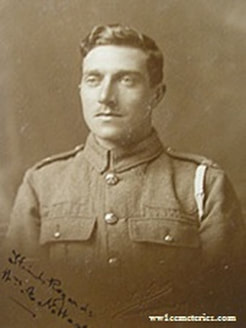
340513 Gunner
William Argent Nottage
354th Siege Battery, Royal Garrison Artillery
11th August 1918, aged 26.
Plot II. F. 3.
Son of the late William and Ellen Nottage, of Wanstead, London: husband of Lillie E. Nottage, of 20, Woodstock Gardens, Goodmayes, Essex.
His headstone bears the inscription; "Faithful Unto Death."
William Argent Nottage
354th Siege Battery, Royal Garrison Artillery
11th August 1918, aged 26.
Plot II. F. 3.
Son of the late William and Ellen Nottage, of Wanstead, London: husband of Lillie E. Nottage, of 20, Woodstock Gardens, Goodmayes, Essex.
His headstone bears the inscription; "Faithful Unto Death."
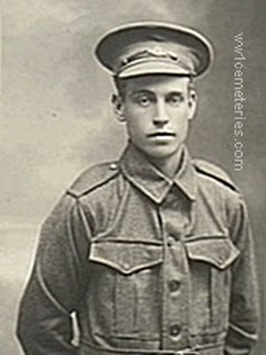
6859 Private
Harry Wilfred Palmer
2nd Bn. Australian Infantry, A. I. F.
15th August 1918, aged 19.
Plot VII. H. 11.
A factory hand from Paddington, NSW prior to enlistment, Pte Palmer embarked with the 22nd Reinforcements from Sydney on SS Port Nicholson on 8 November 1916. After being previously twice wounded in action, he was killed by a shell burst on 15 August 1918, aged 19.
Harry Wilfred Palmer
2nd Bn. Australian Infantry, A. I. F.
15th August 1918, aged 19.
Plot VII. H. 11.
A factory hand from Paddington, NSW prior to enlistment, Pte Palmer embarked with the 22nd Reinforcements from Sydney on SS Port Nicholson on 8 November 1916. After being previously twice wounded in action, he was killed by a shell burst on 15 August 1918, aged 19.
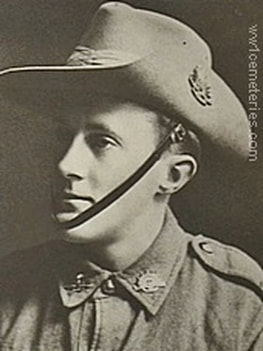
2461 Sergeant
Maurice William Pearse
53rd Bn. Australian Infantry, A. I. F.
16th August 1918, aged 22.
Plot VII. H. 4.
Son of Albert William and Emily Mary Pearse, of 10, Bligh St., Sydney. New South Wales.
His headstone bears the inscription; "He Asked Life Of Thee And Thou Gavest Him A Long Life For Ever." (From Psalm 21:4.)
Originally buried in Morcourt Communal Cemetery Extension, his grave was later concentrated into Heath Cemetery.
A shipping clerk from Strathfield, NSW prior to enlistment, Sgt Pearse embarked with the rank of Private with the 7th Reinforcements, 1st Battalion from Sydney on HMAT Orsova on 14 July 1915. After transferring to the 53rd Battalion he was promoted to Sergeant and on 16 August 1918, aged 22, died of wounds.
4698 Sergeant, F. C. Cullingford was with Maurice Pearse at the time of his death:
"I was with Sgt. Pearse and others going down to bathe at Morcourt when a piece of shell hit him under the arm. He only said 'I am hit' and became unconscious. They got a stretcher and put him on it, but he died on the way to the Dressing Station. He was buried in the cemetery at Morcourt."
Maurice William Pearse
53rd Bn. Australian Infantry, A. I. F.
16th August 1918, aged 22.
Plot VII. H. 4.
Son of Albert William and Emily Mary Pearse, of 10, Bligh St., Sydney. New South Wales.
His headstone bears the inscription; "He Asked Life Of Thee And Thou Gavest Him A Long Life For Ever." (From Psalm 21:4.)
Originally buried in Morcourt Communal Cemetery Extension, his grave was later concentrated into Heath Cemetery.
A shipping clerk from Strathfield, NSW prior to enlistment, Sgt Pearse embarked with the rank of Private with the 7th Reinforcements, 1st Battalion from Sydney on HMAT Orsova on 14 July 1915. After transferring to the 53rd Battalion he was promoted to Sergeant and on 16 August 1918, aged 22, died of wounds.
4698 Sergeant, F. C. Cullingford was with Maurice Pearse at the time of his death:
"I was with Sgt. Pearse and others going down to bathe at Morcourt when a piece of shell hit him under the arm. He only said 'I am hit' and became unconscious. They got a stretcher and put him on it, but he died on the way to the Dressing Station. He was buried in the cemetery at Morcourt."
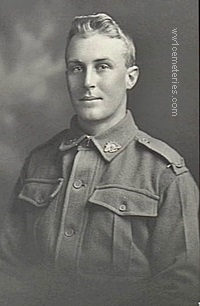
2744B Lance Corporal
Henry Higham Pepper
7th Bn. Australian Infantry, A. I. F.
9th August 1918, aged 25.
Sp. Mem. 13.
Son of Henry and Mary Ann Pepper, of Herbert St., Mordialloc, Victoria, Australia Born at Euroa. Victoria.
His headstone bears the inscription; "Glory, Honour And Peace To Every Man That Worketh Good." (From Romans 2:10.)
A farmer from Nar Nar Goon, Vic prior to enlistment, Pte Pepper embarked with the 6th Reinforcements, 24th Battalion from Melbourne on HMAT Ulysses on 27 October 1915. After transferring to the 7th Battalion he was promoted to Lance Corporal and wounded in action. On 9 August 1918 he was killed in action when he was hit by Machine Gun fire as he advanced.
Henry Higham Pepper
7th Bn. Australian Infantry, A. I. F.
9th August 1918, aged 25.
Sp. Mem. 13.
Son of Henry and Mary Ann Pepper, of Herbert St., Mordialloc, Victoria, Australia Born at Euroa. Victoria.
His headstone bears the inscription; "Glory, Honour And Peace To Every Man That Worketh Good." (From Romans 2:10.)
A farmer from Nar Nar Goon, Vic prior to enlistment, Pte Pepper embarked with the 6th Reinforcements, 24th Battalion from Melbourne on HMAT Ulysses on 27 October 1915. After transferring to the 7th Battalion he was promoted to Lance Corporal and wounded in action. On 9 August 1918 he was killed in action when he was hit by Machine Gun fire as he advanced.
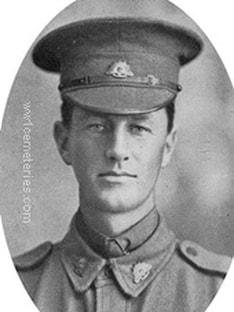
2747 Lance Corporal
Charles Reginald Perrin
60th Bn. Australian Infantry, A. I. F.
9th August 1918, aged 40.
Plot III. E. 16.
Son of Edmund and Kate Annie Alma Perrin; husband of M. E. Pertin, of 24, Lockhart St., Caulfield, Victoria, Australia. Born at Maryborough, Victoria.
His headstone bears the inscription; "Brother Of No.1089 Pte. H. E. Perrin Killed Fleurbaix. 19.7.16." - Harold Edgar Perrin is commemorated at the V. C. Corner Australian Cemetery.
A school teacher prior to enlisting, he embarked from Melbourne aboard HMAT Nestor (A71) on 2 October 1916. On 9 August 1918, he was killed in action near Villers-Bretonneux, France, during the advance on the Amiens front. He was aged 40.
Charles Reginald Perrin
60th Bn. Australian Infantry, A. I. F.
9th August 1918, aged 40.
Plot III. E. 16.
Son of Edmund and Kate Annie Alma Perrin; husband of M. E. Pertin, of 24, Lockhart St., Caulfield, Victoria, Australia. Born at Maryborough, Victoria.
His headstone bears the inscription; "Brother Of No.1089 Pte. H. E. Perrin Killed Fleurbaix. 19.7.16." - Harold Edgar Perrin is commemorated at the V. C. Corner Australian Cemetery.
A school teacher prior to enlisting, he embarked from Melbourne aboard HMAT Nestor (A71) on 2 October 1916. On 9 August 1918, he was killed in action near Villers-Bretonneux, France, during the advance on the Amiens front. He was aged 40.
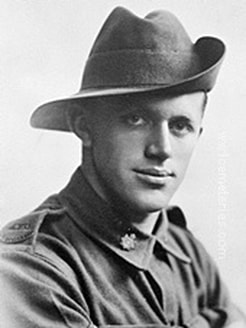
8660 Sergeant
George McAdam Polwarth
59th Bn. Australian Infantry, A. I. F.
9th August 1918, aged 23.
Sp. Mem. 5.
Son of John and Agnes Polwarth, of 45, Prince's St., Flemington, Victoria, Australia.
His headstone bears the inscription; "Ever Remembered In His Loved Australian Home Flemington."
George Polwarth enlisted on 13 July 1915 and embarked from Melbourne aboard HMAT Ceramic on 23 November 1915. He was later promoted to sergeant and was killed in action when a sniper shot him through the left arm and heart on 9 August 1918 at Harbonnieres, France.
George McAdam Polwarth
59th Bn. Australian Infantry, A. I. F.
9th August 1918, aged 23.
Sp. Mem. 5.
Son of John and Agnes Polwarth, of 45, Prince's St., Flemington, Victoria, Australia.
His headstone bears the inscription; "Ever Remembered In His Loved Australian Home Flemington."
George Polwarth enlisted on 13 July 1915 and embarked from Melbourne aboard HMAT Ceramic on 23 November 1915. He was later promoted to sergeant and was killed in action when a sniper shot him through the left arm and heart on 9 August 1918 at Harbonnieres, France.
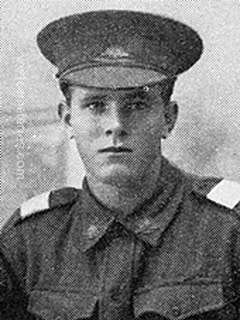
3251 Private
Kenneth George Randell
2nd Bn. Australian Infantry, A. I. F.
23rd August 1918, aged 23.
Plot V. C. 12.
Son of Alfred and Amy Therisa Randell, of Terminus St., Liverpool, New South Wales. Born at Galston.
His headstone bears the inscription; "He Died That We Might Live."
A labourer prior to enlisting, he embarked from Sydney aboard HMAT Suevic (A29) on 11 November 1916. Pte Randell was killed in action, during enemy shelling, near Corbie, France.
Kenneth George Randell
2nd Bn. Australian Infantry, A. I. F.
23rd August 1918, aged 23.
Plot V. C. 12.
Son of Alfred and Amy Therisa Randell, of Terminus St., Liverpool, New South Wales. Born at Galston.
His headstone bears the inscription; "He Died That We Might Live."
A labourer prior to enlisting, he embarked from Sydney aboard HMAT Suevic (A29) on 11 November 1916. Pte Randell was killed in action, during enemy shelling, near Corbie, France.
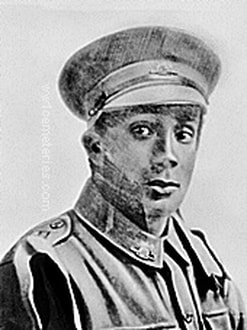
3603 Private
William Reginald Rawlings, M. M.
29th Bn. Australian Infantry, A. I. F.
9th August 1918, aged 27.
Plot I. A. 19.
Son of William and Bessie Rawlings, of Purnim, Victoria, Australia.
His headstone bears the inscription; "The Lord Giveth And The Lord Taketh Away; Deeply Regretted."
William Rawlings was born at the Aboriginal Station of Framlingham, in the western district of Victoria. The family has among its descendants the boxer Lionel Rose and Reginald Saunders, distinguished soldier of the Second World War and Korea and the first Aboriginal to be commissioned in the Army. Rawlings enlisted at Warrnambool on 14 March 1916 and embarked on 1 August 1916 aboard HMAT Orsova from Melbourne, Vic. He joined the 29th Battalion in France. He was awarded the Military Medal for bravery during the heavy fighting along the Morlancourt Ridge on the night 28 - 29 July 1918. The recommendation for Pte Rawling's MM published in the Commonwealth Gazette No 36, 14 March 1919 reads: "At Morlancourt on night 28/29 July 1918. During the attack on enemy system this soldier had the responsible position of first bayonet man in a bombing team which worked down the enemy C.T. [Communication Trench], routing the enemy established a block in the trenches. Private Rawlings displayed rare bravery in the performance of his duty killing many of the enemy, brushing aside all opposition and clearing the way effectively for the bombers of his team. His irresistible dash and courage set a wonderful example to the remainder of the team." Pte Rawlings was killed in action, aged 27 on 9 August 1918, during the capture of Vauvillers, France.
William Reginald Rawlings, M. M.
29th Bn. Australian Infantry, A. I. F.
9th August 1918, aged 27.
Plot I. A. 19.
Son of William and Bessie Rawlings, of Purnim, Victoria, Australia.
His headstone bears the inscription; "The Lord Giveth And The Lord Taketh Away; Deeply Regretted."
William Rawlings was born at the Aboriginal Station of Framlingham, in the western district of Victoria. The family has among its descendants the boxer Lionel Rose and Reginald Saunders, distinguished soldier of the Second World War and Korea and the first Aboriginal to be commissioned in the Army. Rawlings enlisted at Warrnambool on 14 March 1916 and embarked on 1 August 1916 aboard HMAT Orsova from Melbourne, Vic. He joined the 29th Battalion in France. He was awarded the Military Medal for bravery during the heavy fighting along the Morlancourt Ridge on the night 28 - 29 July 1918. The recommendation for Pte Rawling's MM published in the Commonwealth Gazette No 36, 14 March 1919 reads: "At Morlancourt on night 28/29 July 1918. During the attack on enemy system this soldier had the responsible position of first bayonet man in a bombing team which worked down the enemy C.T. [Communication Trench], routing the enemy established a block in the trenches. Private Rawlings displayed rare bravery in the performance of his duty killing many of the enemy, brushing aside all opposition and clearing the way effectively for the bombers of his team. His irresistible dash and courage set a wonderful example to the remainder of the team." Pte Rawlings was killed in action, aged 27 on 9 August 1918, during the capture of Vauvillers, France.
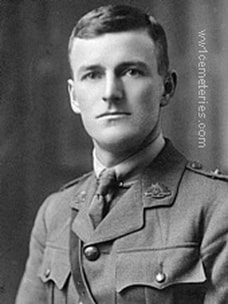
Lieutenant
Eric Mervyn Roach
1st Bn. Australian Machine Gun Corps
10th August 1918, aged 27.
Plot VI. H. 20.
Son of Henry and Minetta Roach, of Swaine Avenue, Toorak, South Australia. Born at Aberdeen, Burra.
His headstone bears the inscription; "Faithfully Served And Gallantly Died 1914-1918."
An electrician with one and a half years service in the Citizens' Military Forces (CMF), Roach enlisted with the rank of Private on 26 August 1914. He embarked with the service number 437 from Adelaide aboard HMAT Ascanius (A11) with the 10th Battalion, Machine Gun Section on 20 October 1914. Private Roach was wounded in action on 25 April 1915 at Gallipoli, however he returned to the unit soon after. He was transferred to the 3rd Machine Gun Company in March 1916 and was promoted to Lance Corporal in August of that year. He was further promoted to Lieutenant on 25 November 1917. Lt Roach was killed in action on 10 August 1918, aged 27, and is buried at Heath Cemetery Harbonnieres, France. In a letter to the Base Record Office in Melbourne in 1922, his father quotes Euripides when discussing his sons "glorious end" - "Who knows but life be that which men call death, and death that men call life."
Eric Mervyn Roach
1st Bn. Australian Machine Gun Corps
10th August 1918, aged 27.
Plot VI. H. 20.
Son of Henry and Minetta Roach, of Swaine Avenue, Toorak, South Australia. Born at Aberdeen, Burra.
His headstone bears the inscription; "Faithfully Served And Gallantly Died 1914-1918."
An electrician with one and a half years service in the Citizens' Military Forces (CMF), Roach enlisted with the rank of Private on 26 August 1914. He embarked with the service number 437 from Adelaide aboard HMAT Ascanius (A11) with the 10th Battalion, Machine Gun Section on 20 October 1914. Private Roach was wounded in action on 25 April 1915 at Gallipoli, however he returned to the unit soon after. He was transferred to the 3rd Machine Gun Company in March 1916 and was promoted to Lance Corporal in August of that year. He was further promoted to Lieutenant on 25 November 1917. Lt Roach was killed in action on 10 August 1918, aged 27, and is buried at Heath Cemetery Harbonnieres, France. In a letter to the Base Record Office in Melbourne in 1922, his father quotes Euripides when discussing his sons "glorious end" - "Who knows but life be that which men call death, and death that men call life."
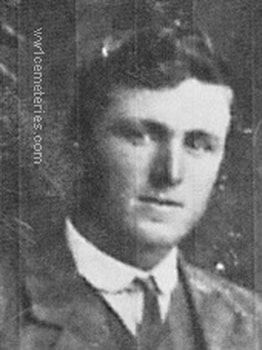
Lieutenant
Thomas John Ross
7th Bn. Australian Infantry, A. I. F.
9th August 1918, aged 34.
Plot IV. J. 18.
Originally buried at Bayonvillers British Cemetery, his grave was later concentrated into Heath Cemetery.
Son of Hugh and Katherine Josephine Ross; husband of Jean Ross, of Ilfracombe, Stawell, Victoria, Australia. Born at Panmure, Victoria.
His headstone bears the inscription; "There Is A Link Death Cannot Sever Love And Remembrance Last For Ever."
A labourer prior to enlistment he embarked from Melbourne with the 16th Reinforcements on HMAT Suffock (A23) on 1 April 1916. Lt Ross was killed in action on 9 August 1918, aged 34.
7541 Private, R. Perry was present when Lieutenant Ross was killed:
"I saw him killed in front of Rosieres at about 3 p.m. by an explosive Machine Gun bullet, which hit him in the head, blowing it half away. Lieutenant Gordon and I carried him two miles back where he was buried with a number of other officers near Rosieres. We hopped over at 12-45 and Lieutenant Ross was rushing this post at the time he was hit. He came from Stawell, Vic., and has a wife and two children, he was a big, dark man, very popular indeed."
Thomas John Ross
7th Bn. Australian Infantry, A. I. F.
9th August 1918, aged 34.
Plot IV. J. 18.
Originally buried at Bayonvillers British Cemetery, his grave was later concentrated into Heath Cemetery.
Son of Hugh and Katherine Josephine Ross; husband of Jean Ross, of Ilfracombe, Stawell, Victoria, Australia. Born at Panmure, Victoria.
His headstone bears the inscription; "There Is A Link Death Cannot Sever Love And Remembrance Last For Ever."
A labourer prior to enlistment he embarked from Melbourne with the 16th Reinforcements on HMAT Suffock (A23) on 1 April 1916. Lt Ross was killed in action on 9 August 1918, aged 34.
7541 Private, R. Perry was present when Lieutenant Ross was killed:
"I saw him killed in front of Rosieres at about 3 p.m. by an explosive Machine Gun bullet, which hit him in the head, blowing it half away. Lieutenant Gordon and I carried him two miles back where he was buried with a number of other officers near Rosieres. We hopped over at 12-45 and Lieutenant Ross was rushing this post at the time he was hit. He came from Stawell, Vic., and has a wife and two children, he was a big, dark man, very popular indeed."
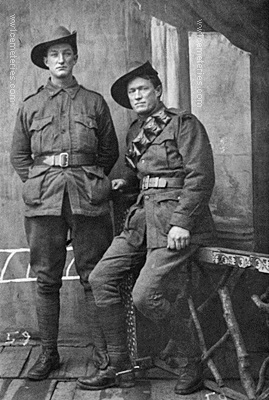
2199 Private
Francis (Frank) Stanislaus Ryan
1st Bn. Australian Infantry, A. I. F.
23rd August 1918, aged 30.
Plot VII. B. 13.
Brothers 2199A Private Francis Stanislaus (Frank) Ryan (left), 1st Battalion, and 2672 Driver Ambrose Bernard Ryan, 3rd Battalion. Prior to enlistment both were storekeepers of Goolma, NSW. Bomber Francis Ryan embarked with the 7th Light Trench Mortar Battery on HMAT Shropshire from Melbourne on 11 May 1917. On 23 August 1918, having transferred to the 1st Battalion and promoted to lance corporal, he was killed in action near Harbonnieres, France, aged 30. Pte Ambrose Ryan embarked with the 8th Reinforcements of the 3rd Battalion on HMAT Runic from Sydney on 9 August 1915. He returned to Australia on 28 March 1919.
Francis (Frank) Stanislaus Ryan
1st Bn. Australian Infantry, A. I. F.
23rd August 1918, aged 30.
Plot VII. B. 13.
Brothers 2199A Private Francis Stanislaus (Frank) Ryan (left), 1st Battalion, and 2672 Driver Ambrose Bernard Ryan, 3rd Battalion. Prior to enlistment both were storekeepers of Goolma, NSW. Bomber Francis Ryan embarked with the 7th Light Trench Mortar Battery on HMAT Shropshire from Melbourne on 11 May 1917. On 23 August 1918, having transferred to the 1st Battalion and promoted to lance corporal, he was killed in action near Harbonnieres, France, aged 30. Pte Ambrose Ryan embarked with the 8th Reinforcements of the 3rd Battalion on HMAT Runic from Sydney on 9 August 1915. He returned to Australia on 28 March 1919.

